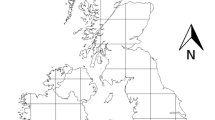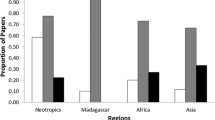Abstract
Patch occupancy by Coenonympha tullia has been surveyed in 166 sites in Northumberland, UK. It was found in 117 of them and absent in 37. Weather conditions were too poor to determine its presence at a further 12 sites. Differences in habitat quality among sites account for patch occupancy as successfully (R2 = 48%) as isolation and patch size jointly (R2 = 46%). This finding has relevance for metapopulation studies as it demonstrates that greater attention should be given to differences in habitat quality among patches beyond their size and distance from one another. Together, habitat quality, patch size and isolation account for 61% of the variation in C. tullia occupancy of sites and discriminant analysis produces a correct classification for > 88% of sites. Habitat quality and patch size jointly account for much the same variance, and result in the same classification of the twelve sites excluded from analysis, as they do in conjunction with patch isolation. This result suggests that there is potential for predicting changes in occupancy of sites from site specific data in the face of changes to biotopes, such as planned exploitation and deterioration of sites from other causes including climate change and management practices.
Similar content being viewed by others
References
Dennis, R.L.H. (1993) Butterflies and Climate Change. Manchester: Manchester University Press.
Dennis, R.L.H., Porter, K. and Williams, W.R. (1986) Ocellation in Coenonympha tullia(Müller) Lep., Satyridae). II. Population differentiation and clinical variation in the context of climatically-induced antipredator defence strategies. Entomologist’s Gaz., 37, 133–72.
Dennis, R.L.H. and Shreeve, T.G. (1996) Butterflies on British and Irish Offshore Islands. Wallingford, Oxford: Gem Publishing Company.
Eales, H.T. (1995) A revision of the Status of the Large Heath Butterfly (Coenonympha tullia) in Northumberland. Confidential Publication for Butterfly Conservation and other supporting organizations.
Eales, H.T. (1996) A Revision of the Status of the Large Heath Butterfly (Coenonympha tullia) in Northumberland. Confidential Publication for Butterfly Conservation and other supporting organizations.
Eales, H.T. and Dennis, R.L.H. (in press) Predicting site occupancy for Coenonympha tullia(Müller, 1764) (Lepidoptera: Satyrinae) using habitat parameters. Entomologist’s Gaz.
Emmet, A.M. and Heath, J. (eds) (1990) The butterflies of Great Britain and Ireland. Colchester, Essex: Harley Books.
Gilpin, M.E. (1980) The role of stepping stone islands. Theor. Popul. Biol. 17, 247–53.
Hanski, I. (1994a) Patch-occupancy dynamics in fragmented landscapes. Trends Ecol. Evol. 9, 131–5.
Hanski, I. (1994b) A practical model of metapopulation dynamics. J. Anim. Ecol. 63, 151–62.
Hanski, I. and Gilpin, M. (1991) Metapopulation dynamics: brief history and conceptual domain. Biol. J. Linn. Soc. 42, 3–16.
Hanski, I. and Gilpin, M. (1997) Metapopulation biology: ecology, genetics and evolution. London: Academic Press.
Hanski, I., Kuusaari, M. and Nieminen, M. (1994) Metapopulation structure and migration in the butterfly Melitaea cinxia. Ecology 75, 747–62.
Hanski, I. and Thomas, C.D. (1994) Metapopulation dynamics and conservation: a spatially explicit model applied to butterflies. Biol. Conserv. 68, 167–80.
Hanski, I., Pakkala, T., Kuusaari, M. and Lei, G. (1995) Metapopulation persistence of an endangered butterfly in a fragmented landscape. Oikos 72, 21–8.
Harrison, S. (1991) Local extinction in a metapopulation context: an empirical evaluation. Biol. J. Linn. Soc. 42, 73–8.
Hill, J.K., Thomas, C.D. and Lewis, O.T. (1996) Effects of habitat patch size and isolation on dispersal by Hesperia commabutterflies: implications for metapopulation structure. J. Anim. Ecol. 65, 725–35.
Joy, J. (1991) The ecology and life history of the large heath butterfly (Coenonympha tullia) on the Shropshire/Clwyd mosses. Brit. Ecol. Soc. Bulletin 22, 114–19.
Joy, J. and Pullin, A.S. (in press) The effects of flooding on the survival and behaviour of overwintering large heath butterfly Coenonympha tullialarvae. Biol. Conserv.
Kareiva, P. and Wennergren, U. (1995) Connecting landscape patterns to ecosystem and population processes. Nature 373, 299–302.
Lunn, A. (1974) The Vegetation of Northumberland Moorland Communities, with selected Coastal, Aquatic and Scrub Communities. Department of Geography, Newcastle-upon-Tyne.
Melling, T. (1984) Discovery of the larvae of the large heath in the wild. Entomologist’s Rec. J. Var. 96, 231–2.
Melling, T. (1987) The Ecology and Structure of a Butterfly Cline. PhD Thesis, University of Newcastle-upon-Tyne.
Nature Conservancy Council (1990) Handbook for Phase I Habitat Survey. A Technique for Environmental Audit.Peterborough: English Nature.
Pollard, E. and Yates, T. (1993) Monitoring Butterflies for Ecology and Conservation. London: Chapman & Hall.
Reid, C.A.M. (1984) The Status of the Large Heath Butterfly in Northumberland. Confidential Report to the Northumberland Wildlife Trust.
STATISTICA (1994) STATISTICA for Windows I-III. Tulsa, OK: Statsoft Inc.
Swan, G.A. (1993) Flora of Northumberland. Natural History Society of Northumbria.
Thomas, C.D., Thomas, J.A. and Warren, M.S. (1992) Distributions of occupied and vacant habitats in fragmented landscapes. Oecologia 92, 563–7.
Thomas, C.D. (1994) Extinctions, colonization, and metapopulations: environmental tracking by rare species. Conserv. Biol. 8, 373–8.
Thomas, C.D. (1995) Ecology and conservation of butterfly metapopulations in the fragmented British landscape. In Ecology and Conservation of Butterflies(A.S. Pullin, ed.) pp. 46–63. London: Chapman & Hall.
Thomas, J.A. (1984) the conservation of butterflies in temperate countries: past efforts and lessons for the future. In The Biology of Butterflies(R.I. Vane-Wright and P.R. Ackery, eds) pp. 333–53. London: Academic Press.
Author information
Authors and Affiliations
Rights and permissions
About this article
Cite this article
Dennis , R.L., Eales , H.T. Patch occupancy in Coenonympha tullia (Muller, 1764) (Lepidoptera: Satyrinae): habitat quality matters as much as patch size and isolation. Journal of Insect Conservation 1, 167–176 (1997). https://doi.org/10.1023/A:1018455714879
Issue Date:
DOI: https://doi.org/10.1023/A:1018455714879




